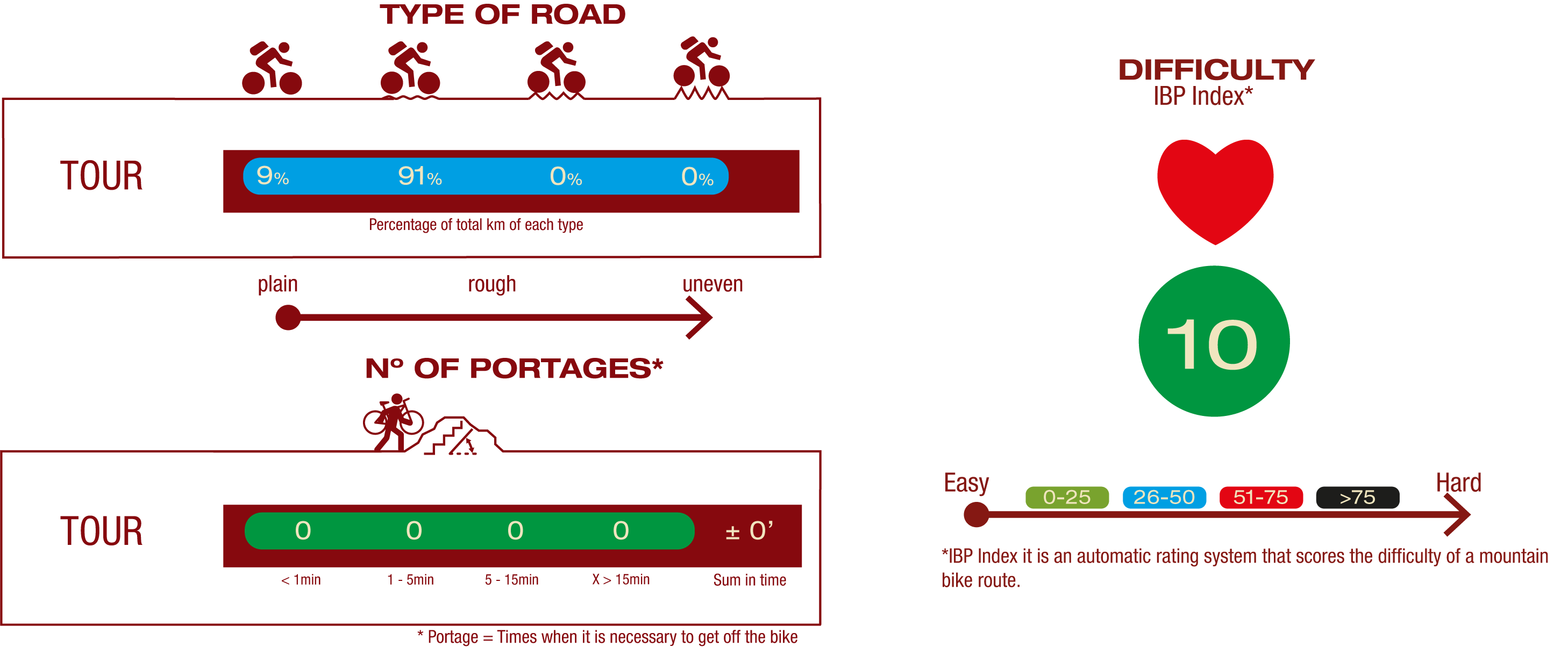Net of Natural
Trails

Stage: Caudiel - Altura
Description
Discovering places steeped in history
A stage of less than 18 kilometres through the central area of the comarca of Alto Palancia, visiting towns like Caudiel and Altura, marking the beginning of the end of the trail, also passing through Jérica and Navajas. The natural heritage is also impressive, with the Curs Mitjà del Riu Palància Site of Community Interest and La Esperanza Municipal Natural Site. There is also the railway history, with a total of 5 tunnels, as well Mataburros Bridge and the Cascajar and Palancia River Viaducts.

Caudiel marks the beginning of this stage, and we leave the town behind where once the old mining railway did. Before leaving, it is worth visiting the town to see its vast architectural heritage, including Ánibal Tower and the Church of San Juan Bautista.
In this first part of the route, Aleppo pine forest (Pinus halepensis) dominates the landscape, with small plots of small-scale tree cultivations dotted around the woodland. The road runs parallel to the railway line in use today, as in previous stages. It also shares its route with stage 48 of the Camino del Cid and the GR-160 long-distance waling train.
At a bend in the old railway line to the left, we reach the Novales rest area, a perfect place to recharge the batteries. A little further on we reach the Cascajar Viaduct, with its three archers, offering impressive panoramic views. Beyond the viaduct, we pass through a tunnel so short we can see light the end of the tunnel, and then a longer one equipped with lighting. All the same, it is recommended to carry a torch. A third tunnel, with no lighting, leads to a small rest area.

Soon after, the route enters a section through the town of Jérica. Here, it is important to pay attention to the signposting to navigate our way through the town without getting lost. Before continuing, it is worth enjoying its charms, such as the Mudéjar bell tower and Homenaje Tower.
After the satisfying visit through the town, we leave the town along the Avenida de Valencia, which ends at the Municipal Cemetery. From here we take an asphalted cycle lane that runs parallel to the CV-2330 road. We carefully cross the road at the zebra crossing near the Waste Water Treatment Plant. The cycle lane continues and, a little further on, the old mining railway line is rejoined at the old Santa Bárbara level crossing, which is equipped with a rest area.
After a little more than a kilometre, we cross the viaduct over the River Palancia, which allows you to enjoy the riverbed and its rich riverside vegetation. We then reach the old Jérica station, which now has a rest area shaded by several Aleppo pine trees. A little further on, we cross the A-23 motorway via an underpass. Returning to the old railway line once again, after about two kilometres, we reach a tunnel equipped with lighting inside. A short while later, coinciding with a new kilometre marker, we reach the Mirador del Regajo viewpoint, offering the best views of the Embalse del Regajo reservoir and an ideal spot to take a break and admire the calm landscape.

Continuing on our way, we reach another tunnel, equipped with lighting, before the Cantera de Navajas rest area, where we can see the remains of the old loading platforms. A crossroads indicates the proximity of the small town of Navajas, with a campsite next to the route. This town is well worth a stop to visit the Church of La Inmaculada Concepción and, if you have time, you the natural site of Salto de la Novia, a spectacularly impressive waterfall on the course of the River Palancia.
The route continues alongside the Navajas campsite to pass under a bridge whose curious name, which appears on a sign, will no doubt amuse passers-by: Puente donde se cayó la burra y no se mató or “Bridge where the donkey fell and was not killed” . We cross the CV-216 road, taking the necessary precautions, and leave the town of Navajas.
We then passes under the CV-216 road via a newly built underpass, and then the A-23 motorway. At the end of the second underpass, the route offers two options: continue along the old railway line or take an alternative path, which in just over 500 metres reconnects with the main route, resuming the journey along the old railway line.
Just a few metres after the end of the alternative route, you'll reach the first houses of the town of Altura. After crossing several streets following the old railway line, we reach the final point of the stage. On arrival, we can enjoy the Church of San Miguel Arcángel, the Plaza Mayor, the 16th century Casa Grande and a whole network of historic aqueducts and bridges that invite you to wander through the streets of Altura.
Managing Entities
Sites of interest
Puntos de interés
Hydrography
Information
Infrastructure
- Antigua Estación de Caudiel
- Rambla Monteros
- Túnel
- Puente de Mataburros
- Túnel
- Antigua Estación de Jérica
- Viaducto del Cascajar
- Túnel
- Puente donde se cayó la burra y no se mato
- Cargadero
- Viaducto del Río Palancia
- Túnel
Municipality
Passport
Profile

(Calculated according to the MIDE criteria for an average excursionist with a light load)
Highlights
Salto de la Novia
Salto de la Novia, or “Bride’s Leap” is a natural area belonging to the municipality of Navajas in the province of Castellón. Here we find the Brazil waterfall, 60 metres high, on the course of the River Palancia, opposite the expanse of Mount Rascal.
This is natural space of great beauty and a great tourist attraction for the area. A local legend goes that many years ago, if a couple wanted to marry, to prove their love, they had to pass a test. They would come here and, in front of the whole village, at the narrowest part of the river, the bride had to cross the river in a single leap, which was understood as a symbol of happiness for her future marriage and a sign of fidelity.
If they failed to do so, it was considered the marriage could not go ahead, and they themselves, believing that it would be unhappy, would break off their engagement. Legend also has it that a girl, while trying to cross the river, missed her jump and fell into a whirlpool. Her fiancé tried unsuccessfully to save her, leaving them both trapped in the whirlpool where they disappeared under the water, their drowned bodies later found. It is said that, on nights with full moon, a sweet and sad song of lament can be heard for the death of the two lovers.
Multimedia
Downloads
GPS Downloads
Documents
Cyclability
CICLABILITY
This Cyclostage corresponds to stage Caudiel - Altura and stage Altura - Algimia de Alfara of the Nature Trail
TYPE OF ROADS, PORTAGES & DIFFICULTY
SAFETY RECOMMENDATIONS
There are eleven tunnels, eight of them without artificial lighting. Urban sections through Caudiel, Jérica and Altura with road crossings and three sections shared with motor vehicles.
GENERAL RECOMMENDATIONS
- Find out about the technical aspects of the route and the weather on the day.
- Take care of the environment. Take care not to disturb animals or damage vegetation. Respect private areas.
- You must give priority to pedestrians and comply with general traffic rules.
- The environment in which you will be riding is open, free to move around and an area where many activities are carried out (sporting, forestry, livestock and agricultural activities).
- Always have an understanding, prudent, responsible and respectful attitude.





